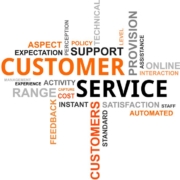Judging from the customer satisfaction score (CSAT) and voice of the customer (VOC) research Ideba regularly conducts, customer expectations seem to be funneling into two main categories. The categories define what customers expect from the product(s) and what they expect from the companies that provide them.
The first category I call “set it and forget it.” These are solutions that enable basic functions within their solution category—so basic, in fact, that the goal is that your organization will find it unthinkable to muddle through without them. Solutions in the bucket automate basic tasks in various categories (communication, transcription, accounting, etc.), simplifying tasks while becoming central to efficient workflows. The ultimate in this realm is Microsoft Word. Everyone expects Word to be there, and to function. There are few complexities around it at this stage. As part of Office 365, it pairs with other critical tools like PowerPoint and Excel. Cloud-based, organizations expect regular security updates, and feature/functionality improvements that keep it on par or superior to the competition and other tools on the market. MS Word and Office 365 of which it’s a part, are the ultimate “set it and forget it” products; if they’re reliable and regularly updated with new features and functionality, customers are happy. They offer a limited set of self-service customizations, requiring little to no maintenance.
The second category is “service intensive.” These solutions tackle more complex, fluid problems and scenarios, e.g., complex accounting and financial forecasting, workflow processes, and agent enablement. Here, customers expect much more. They not only want solutions that function reliably, the solutions must also adapt. One business won’t be identical to another organizationally or financially and each will have unique needs. Because the necessary flexibility adds complexity, you need higher levels of expertise to implement and maintain service intensive solutions. Updates aren’t just self-contained downloads, but impact multiple processes and systems; you must plan for them. Thus, customers want more of a partnership relationship with the vendor. They want to know that service will be there when they need it. They need to know what’s in the pipeline so they can prepare.
It’s surprising how many organizations mis-categorize themselves; companies with set-it-and-forget-it solutions want to behave like service-intensive orgs, and vice versa. Granted, there can be gray areas, but in general, when vendors provide fixed functionality with included customization options that operate identically in most scenarios, you’re providing a set-it-and-forget-it service. That doesn’t mean your solution is any less valuable than a service intensive one. It just means that your customers need less from you because your solution demands less of them. Communicate with customers, yes, but don’t expect them to require regular consultation with you, and don’t impose it on them. Let salespeople sell what you actually offer right now—hopefully a reliable service that provides (insert benefit here) from a customer-centric organization that’s continually innovating to meet changing needs.
Companies with solutions that require more of the customers—who don’t provide it—risk the most. They risk unsatisfied customers and the perception of weak products. A complex solution sold without adequate training and ongoing learning options will be underutilized and provide less value. It may frustrate users. A complex solution without adequate, prompt service options will further alienate customers.
Part of the value of CSAT and VOC research is knowing if you might need to adjust your place on the set-it-and-forget-it to service-intensive scale. How do customers feel about your training, and about your service? Do they feel the need for more roadmap information? Do they feel you over-communicate? Do they want further extensions of the set-it-and-forget it solution, or do they need you to extend into the service-intensive realm?
Knowing how customers perceive your products—knowing what you’re selling from the customer’s POV—allows you to prepare new customers for the user experience. It limits surprises, and helps cement customer satisfaction.
-Leonce Gaiter, VP of Content and Strategy






